Amir-Abbas Hoveyda
Amir-Abbas Hoveyda (Persian: امیرعباس هویدا, romanized: Amīr `Abbās Hoveyda; 18 February 1919 – 7 April 1979)[1] was an Iranian economist and politician who served as Prime Minister of Iran from 27 January 1965 to 7 August 1977. He was prime minister for 13 years and is the longest serving prime minister in Iran's history. He also served as Deputy Prime Minister and Minister of Finance in Mansur's cabinet. After the Iranian Revolution, he was tried by the newly established Revolutionary Court for "waging war against God" and "spreading corruption on earth" and executed.
Amir-Abbas Hoveyda | |
|---|---|
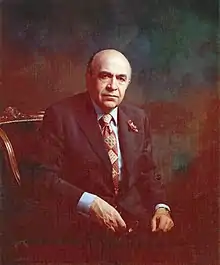 | |
| 42nd Prime Minister of Iran | |
| In office 26 January 1965 – 7 August 1977 | |
| Monarch | Mohammad Reza Pahlavi |
| Preceded by | Hassan-Ali Mansur |
| Succeeded by | Jamshid Amouzegar |
| Minister of Finance | |
| In office 7 March 1964 – 1 February 1965 | |
| Prime Minister | Hassan-Ali Mansur |
| Preceded by | Kamal Hassani |
| Succeeded by | Jamshid Amouzegar |
| Minister of Royal Court | |
| In office 7 August 1977 – 6 November 1978 | |
| Prime Minister | Jamshid Amouzegar |
| Preceded by | Asadollah Alam |
| Succeeded by | Ali Gholi Ardalan |
| Personal details | |
| Born | 18 February 1919 Tehran, Persia |
| Died | 7 April 1979 (aged 60) Tehran, Iran |
| Resting place | Behesht-e Zahra Cemetery |
| Political party | New Iran Party (1964–1975) Rastakhiz (1975–1978) |
| Spouse(s) | |
| Parents | Habibollah Eynolmolk Ashraf Molok Sardari |
| Alma mater | Université libre de Bruxelles |
| Signature |  |
Early life and education
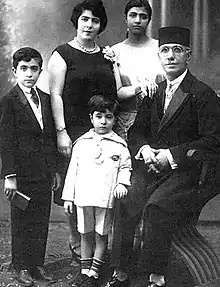
Born in Tehran in 1919 to Habibollah Hoveyda (Ayn ol-Molk), a seasoned diplomat,[2] who was mostly active during the latter years of the Qajar dynasty, and Afsar ol-Moluk, a descendant of the royal family that Hoveyda would serve for much of his adult life. Hoveyda's father was a lapsed adherent of the Baháʼí Faith and Hoveyda himself was not religious.[3] He was the nephew of Abdol Hossein Sardari, also known as "Schindler of Iran". Because of the responsibilities borne by diplomats such as Ayn ol-Molk, the Hoveyda family was never fixed in one residence for any prolonged length of time. Studying in various countries gave Hoveyda a unique cosmopolitan flair that would remain being his most enduring characteristic. During the family's stay in Beirut, Lebanon, Hoveyda attended Lycée Français, an institution affiliated with the French government. His love for France and its culture are rooted in his tutelage at the lycée. French literary works by the likes of André Gide, André Malraux, Molière, and Baudelaire, captivated the young Hoveyda and gave way for his intellectual growth. Some pundits suggest that it was Hoveyda's intellectual prowess which initially attracted him into the Shah's folds.
Hoveyda's desire to attend a French university in 1938 made the young student jump the gun by entering the country of his dreams without completing specific high school prerequisites required for entry. Cited as being the main reason behind Hoveyda's organizational miscalculation was the possibility of military action by an ostensibly belligerent Nazi Germany. Any future occupation of the country would have hindered his chances of attending a French university. Stranded in France, Hoveyda decided to complete the required high school credits in London, England, a city that would come to depress the young man. Aside from completing his educational requisites, Hoveyda was able to sharpen his command of the English language. His ability to communicate in several languages, including Persian, French, English, Italian, German, and Arabic, helped him climb the political ladder later on in life. Hoveyda's return to France in 1939 would be short lived, nevertheless, due to a brewing diplomatic scuffle between the French government and Reza Shah Pahlavi. Having no choice but to leave France again, Hoveyda enrolled at the Free University of Brussels in Brussels, Belgium, during the same year. His stay at the university would be markedly ephemeral because of the effects of the German Blitzkrieg which used Belgian territory as an entry route into France. After being displaced for a short time, Hoveyda was able to return to the Belgian university, obtaining a bachelor's degree in political science in 1941, under the ever-watchful eye of the occupying German administration.
Military and public service
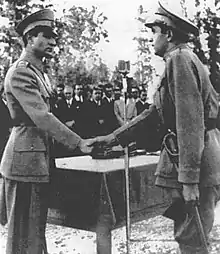
Upon his return to Iran in 1942, Hoveyda rested for a few months before enlisting as a soldier in Iran's national army. His plan at the time was to use his experience as a conscript to supplement his seniority at the foreign ministry where he applied for employment prior to being drafted. Because of his higher education, Hoveyda was able to bypass boot camp and directly enter the Officer's Academy. Iran's modern Prime Ministers, until that point, were able to avoid military service, but Hoveida voluntarily chose to enlist. Although rooted in aristocracy himself, Hoveyda's decision is portentous in the sense that resources that were readily available for his predecessors were often scarce for the young government official.
The Foreign Ministry dispatched a message eight months later confirming Hoveyda's appointment. To some, the quick application process is evidence enough to suggest that there were influential forces that helped expedite Hoveyda's subsequent employment. These claims, however, are often based on hearsay rather than substantiated facts. During his time in the Ministry, Hoveyda befriended many elements of Iranian high society, including the likes of Sadeq Hedayat and Sadeq Chubak. His affinity for the country's intelligentsia is clearly observed in his earlier strategy as PM. By trying to consolidate the partnership between the monarchial regime and the intellectual opposition, Hoveyda believed that the incremental reforms he desired would bear fruit. Others like Jalal al-e Ahmad, writer and social and political critic, saw Hoveyda's ‘infiltration’ of Iran's intellectual ranks as a form of sycophancy. On the other hand, Hedayat and other eccentric characters were quick to identify and repel opportunists who were attempting to leech off their social status. Hedayat and others never distanced themselves from Hoveyda, symbolizing the latter's authenticity.
As Hoveyda garnered more experience, opportunities within Iran's governmental apparatus were becoming available to him. In August 1944, for instance, he accepted a position to accompany Zein ol-Abedin Rahnema, Iran's minister plenipotentiary, to France. Being an avid Francophile, Hoveyda would enjoy his time as an embassy official, but he would soon be entangled in an international scandal that would taint him for the rest of his life. The "Paris Story" recounts the illegal importation of financial assets, stored in Swiss banks during the war for security purposes, from Switzerland into the coffers of wealthy French businessmen in 1945. To avoid border taxes, diplomatic personnel were persuaded to act as the intermediary, simply because embassy vehicles were, by law, unable to be searched. Although Hoveida never had anything to do with the illegal transfers, his mere association with some of those indicted was enough for him to be used as a scapegoat in the affair.
Aside from experience, patronage from the likes of Abdullah Entezam, an independent minded diplomat of "sterling reputation", served to aid Hoveida's ascendance to the upper echelons of public office. With the government of Mohammad Reza Shah Pahlavi, the Shah (king) of Iran, the only way to obtain high ranking positions in any societal position was through crucial internal patronage, reinforcement Hoveyda sufficiently lacked prior to working with Entezam. The two first got to work together when Hoveyda was stationed in Stuttgart, West Germany. While there in 1947, Hoveyda was assigned with the task of negotiating over deals made between Iran and Germany. The most notable case involved Iran's purchase of factory equipment required for the construction of a steel mill, in which the transaction of the material components were never successfully completed.

In 1950, Hoveyda returned to an ever-changing Iran once again. This time, he would be caught in one of the most tumultuous periods of Iran's modern period. As Hoveyda toiled away at a notably boring job as assistant director of the public relations office at the Foreign Ministry, Mohammad Mossadegh was mobilizing nationalist sentiment as he rose to power. During this period, Entezam was appointed as minister of foreign affairs, allowing Hoveyda to assume a more intellectually stimulating role as Entezam's executive secretary. His tenure did not last long before Mossadegh was appointed Prime Minister, dissolving the former cabinet along with Hoveyda's job.
Leaving Iran once again in 1952, Hoveyda was able to secure a position with the United Nations High Commissioner for Refugees through the help of his European contacts. As a liaison officer, he was given the task of visiting various continents, including Asia, Africa, and the Americas, promulgating the plight of refugees and in effect receiving several commendations from high ranking UN officials.
The Iranian embassy in Turkey would serve to be Hoveyda's final official position outside Iran's frontiers. Assistant to the ambassador, who so happened to be the father of his good friend, Hassan-Ali Mansour, Hoveyda would make a quick exit after Mansour's father was replaced by an authoritarian army general in 1957.
Rise to power

Hoveyda's rise to power involved many years of service within the ministry of foreign affairs, but this path took on a whole new approach once he joined the Board of Directors of the National Iranian Oil Company (NIOC) in 1958 at the behest of his patron Abdullah Entezam, who had by then assumed a high ranking position at the company. As managing director and special assistant to Entezam, Hoveyda used his experiences in the West to transform management-worker relations. As an example, he introduced innovative methods by which workers filed grievances in regard to any aspect of the working environment they deemed unsatisfactory, and helped to figuratively enmesh the roles of management and the labourers into a collective entity. One way he went about doing this was by eating many of his meals alongside wage labourers in the cafeteria. Although he advocated the emulation of Western models to improve overall productivity and worker relations, Hoveyda was very outspoken in favour of expelling foreign technicians and attracting indigenous sources of labour. It was during his tenure in which the NIOC's periodical, Kavosh (Exploration), was first published. What is unique about this magazine is that it was, initially, virtually void of any semblance of the growing cult of personality which surrounded the Shah.
Continuing his duties as managing director at the NIOC, Hoveyda also helped Hassan Ali Mansour in establishing a semi-independent group of highly trained, Western educated, and young technocrats. The organization's main goal was to devise methods of rectifying the nation's ailing economy. Known as the Progressive Circle, this government sponsored dowreh ("Persian for a gathering held at regular intervals") was a deliberate attempt by the shah to thin out the older generation of politicians with a new ‘progressive’ crop. With its inception in 1959, the Circle acted in conjunction with a similar government commission called the Plan Organization. Hoveyda would play a major leadership role in the Circle and would be the catalyst behind much of its recruitment efforts.
Besides experience and patronage, Freemasonry was seen by many politicians at the time as a supplemental credit towards obtaining high ranking government positions. It is no doubt that many members of the Foroughi Lodge, the chapter Hoveyda would eventually join, harboured and produced many influential politicians of Iran's modern era. Hoveyda became a Freemason in 1960 believing that his mere association with the organization would help propel him into the national spotlight. Hoveida would succeed in this regard, but the attention he received was all but positive. Freemasonry in Iran has always been seen as an extension of British imperialism, and with rumours surrounding Hoveyda's religious persuasion, opportunities to attack Hoveyda's character were not taken for granted by his political adversaries during his years as head of foreign policy and Prime Minister. It is well documented that Court Minister Asadollah Alam and General Nasiri of SAVAK, Iran's domestic security and intelligence service, helped expedite the publication of key controversial books against Freemasonry, referencing Hoveyda in each piece. Rumours were also spread by his detractors that he was a Baháʼí, a persecuted religion in Iran, but both he and the Shah denied that he was a Baháʼí.[4][5][6]
Term as Prime Minister
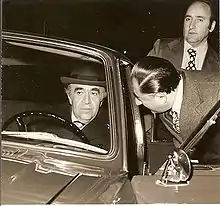
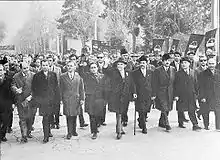
When the Progressive Circle soon became a political entity in the form of the Iran Novin (New Iran) Party in 1963, Hoveyda would be thrust into the national scene. Flanking Prime Minister Hassan Ali Mansour as his Minister of Finance in 1964, the now well seasoned Hoveyda would make his mark by acting as the cabinet's intellectual centre. Many observers, both within and without Iran, would take note of Hoveyda's prudent behaviour and shrewdness. To many, he embodied the archetypical statesman. Hoveyda's positive attributes would again be shrouded by scandal and gossip. During the early months of Mansour's premiership, the government was attacked for ratifying a bill which allowed foreigners extraterritorial rights. More specifically, those who benefited from the law were U.S. military personnel and their dependents. These "capitulation rights" would have a negative impact on the way government at the time was seen by the populace. Because the actions of the government were, by law, reflective of the sitting cabinet at the time, disregarding individual ministerial involvement, Hoveida was also blamed for the bill's implementation even though he was not directly involved in its drafting.
Mansour's assassination on 21 January 1965, by a seventeen-year-old devotee of the Fada’yan-e Islam, would completely alter Hoveyda's future. As he personally reported the news to an obviously distraught shah, he was ordered to formulate a cabinet. Hoveyda would replace the deceased Mansour as the longest running premier in Iran's modern history. It is important to note, however, that the sense of autonomy seen among past Prime Ministers such as Ali Amini, Haj Ali Razmara, and Mohammad Mosaddegh, has been systematically marginalized by the autocratic Mohammad Reza Shah. In his rather successful campaign at consolidating power, the king maintained his international image as a constitutional monarch, but Hoveida's tenure as PM attests to how this portrayal was not an objective reflection of circumstances. Hoveyda's premiership would be the pivot behind his resistance to such powerlessness. Hoveyda's became a household name in Iran through the constant character assassination he received by the late Towfigh magazine, Iran's most popular political satire magazine. Hoveyda was largely unknown among the population of Iran before Towfigh publisized him. He was caricatured in Towfigh's weekly magazine carrying a cane (caused by a traffic accident in which he was involved), wearing one carnation in his suit jacket pocket, and smoking a pipe. Towfigh magazine referred to him as "The Caned One" and even devoted an entire book dedicated to exposing his flaws as a premier entitled "Assa-Nameh". The magazine (and Iranian media in general) frequently criticized and lampooned Hoveyda, primarily because they intended to criticize the Shah himself, but were unable to directly do so due to censorship.
The first half of Hoveyda's premiership is marked by a sense of optimism. As already mentioned, in 1966, Hoveyda attempted to allure many elements of the intellectual community, as well as the opposition, into an informal agreement with the regime. Although talks between the two sides eventually broke down, Hoveyda never lost sight of what a partnership between the two could have accomplished. His pragmatic approach to politics allowed him to envision an incremental reform process that can be carried out through action. This is contrary to the path assumed by many Iranian intellectuals at the time, which involved quixotic solutions to problems such as electoral corruption and media censorship. Hoveyda resumed many of the reform initiatives set out by the Mansour administration. In particular, reform plans that were laid out by the Shah in the White Revolution. Although a secularist, he would even allocate government revenue to the clerical establishment. The clerical establishment was seen as a bulwark against Communism by the Shah, and was constantly reinforced (a policy that the Shah would later regret).

Hoveyda's plan to crack down on corruption became an example of the entrenched ineptitude of many in power. Many important members of the government were corrupt, and the Shah was consistently flattered and schmoozed by them and turned a blind eye to the problem. The Shah began receiving an increasingly distorted picture of Iranian society, while becoming completely blind to increasing frustration to this rule by regular Iranians, as well as the shortcomings of his own government. Hoveyda's inability to move forward with his personal mandate eventually turned the overtly optimistic prime minister into a cynic. After years of political maneuvering, most of his proposed initiatives were stonewalled by bureaucratic obstacles. During the 1970s, the now veteran Prime Minister became nonchalant when it came to following through with his own convictions. His earlier aggression towards the dysfunctions of an obtrusive system slowly turned into feigned support. Publicly, Hoveyda assumed the notion that the regime in its current state would eventually reform on its own, and that political liberalization was only a small issue in the grand scheme of modernization. In private, Hoveyda often lamented over Iran's conditions, admitting to insufficiencies of the state and his own political impotence. The powerlessness of the premier's office was coupled with intricate internal rivalries. Hoveyda had an intensely rough relationship with the likes of Asadollah Alam and Ardeshir Zahedi, son of the famed participant in the 1953 coup against Mossadegh, General Fazlollah Zahedi.
Minister of Court and final years
.jpg.webp)
On 2 March 1975, the shah dissolved the Iran Novin Party and its opposition elements in creating a single party system headed by the Rastakhiz (Resurgence/Resurrection) Party. In relation to Hoveyda, it is believed that the shah was being threatened by the growing influence wielded by party officials, Hoveyda being the most notable. The growth of an independent apparatus was contrary to the Shah's contrivance involving the consolidation of all power. Hoveyda's inability to garner any type of power base in government allowed him to concentrate much of his energy on developing the Iran Novin Party. The networks he had slowly developed over the years came to trouble the monarch. Although Hoveyda would be coerced into relinquishing his position as prime minister, he accepted a temporary intermediary role as secretary general of Rastakhiz before a new Prime Minister can be appointed. Nevertheless, the Shah still saw Hovedya as a trusted (if not pliable) figure, and he was appointed to be minister of court. In her memoirs, Queen Farah wrote that asking Hoveyda to leave the post of prime minister was as painful as "giving birth to a baby".
Hoveida would serve as minister of court within Jamshid Amouzegar's government in 1977. With this role, he would come to discover the pervasiveness of internal corruption, once concealed by Asadollah Alam and the team he had surrounded himself with. Nevertheless, he continued to tolerate the practice as well, while simultaneously remaining a trusted advisor to the Shah.
Hoveyda was alleged to have been the author of an article which attacked the opposition figure the Ayatollah Ruhollah Khomeini as being a British agent and a liar, which was anyonymously published in Kayhan newspaper on January 1978 on the Shah's orders. Whether or not the allegations were true, the article generated a major backlash among Khomeini's supporters, which eventually spiralled into the Iranian Revolution.
At this point, the growing tide of revolution was becoming discernible, giving Hoveyda ample opportunity to leave the country before revolutionary forces could have had a chance to overthrow the 2500-year-old monarchy. Aside from persistent efforts by family and friends to leave the country as quickly as possible, the Shah himself proposed Hoveida with an ambassadorial position to Belgium. His refusal to leave the country can be judged as being a result of naïveté or blind optimism, but Hoveida's decision can also be assessed from alternate angles. For one, he did not want to abandon his mother who was incapable of traveling at the time. On a more personal level, Hoveyda came to the conclusion that after years of self-exile, he would do all he could to remain in Iran. With all these points of rationale being considered, Hoveida actually came to believe that revolutionary fervour was capable of being contained and that everything would eventually straighten out, allowing the country to resume its present course.
In an effort to slow down the momentum of the revolution, the Shah was advised by many of his surrounding advisors to arrest Hoveida, using him as a scapegoat for the past-ills of the crumbling regime. Since Hoveyda was widely seen as a major cause of the revolution due to much of the bad press he had generated throughout the years by newspapers that wanted to indirectly attack the Shah's policies, they reasoned that the public would be appeased. In September, Hoveyda was forced to resign his position of Minister of Court. On 7 November 1978, Hoveyda was arrested together with other 60 former officials.[7] He would be held under house arrest in an upper-Tehran residence often affiliated with SAVAK activity, and the Shah assumed that he would be put on trial, and freed after publicly vindicating himself.
However, once the Shah fled the country, the SAVAK (Iranian state security) agents assigned with the task of guarding Hoveyda, absconded from their posts, leaving Hoveida open to arrest by revolutionary forces. Hoveyda refused requests by friends and relatives to flee Iran before it was too late, and instead turned himself into the authorities. Hoveyda believed that as the trial would be before an Islamic court, and that he personally had done nothing wrong, he would be acquitted.
Trial and execution
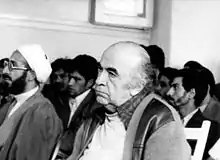
Hoveyda was taken to the Refah School, a temporary headquarters for the revolution's vanguard. Because of the departure of the Shah and much of the ruling class, Hoveyda had become the most prized prisoner of the old government. On 15 March 1979, he would face the newly established Revolutionary Court for the first time. During this time he attempted to create his legal arguments for the court. He was interviewed by Belgian journalist Christine Ockrent, a now infamous interview in which Hoveyda was subject to near accusatory questions by the interviewer.[8]
The clerical judge appointed by Khomeini, Sadeq Khalkhali, would come to be known as the 'Hanging Judge' for his violent approach to revolutionary justice. He was the head of the tribunal that had assembled to try the former prime minister. Prior to Hoveyda's trial, Khalkhali had already ordered the execution of dozens, possibly hundreds of political prisoners, and would eventually be responsible for thousands of executions. Traditional conventions of the judiciary had all but been abandoned during the trials of Hoveyda and countless others. Among many of the anomalous traits personified by the trial, the court ignored notions of due process, impartiality of the judge, or allowing the defendant to consult legal options. Many pundits have come to conclude that the verdict was already made by the Ayatollah Khomeini before the trial ever commenced. Khalkhali's indictment of Hoveyda was as follows:[9]
- Amir Abbas Hoveyda, son of Habibollah, birth certificate number 3542, issued in Tehran, born in 1298 (1920), previously minister of the deposed royal court, and the Shah's ex-Prime Minister, a citizen of Iran, is accused of:
- Spreading corruption on earth.
- Fighting God, God's creatures and the Viceroy of Imam Zaman.
- Acts of sedition detrimental to national security and independence, through forming cabinets that were puppets of the United States and England and defending the interests of colonialists.
- Plotting against national sovereignty by interference in elections to Majlis, appointing and dismissing ministers at the behest of foreign embassies.
- Turning over underground resources: oil, copper and uranium, to foreigners.
- Expansion of the influence of American Imperialism, and its European allies, in Iran by destroying internal resources and turning Iran into a market for foreign commodities.
- Paying national revenues from oil to the Shah and Farah and to countries dependent on the West and then borrowing money at high interest, and enslaving conditions from America and Western countries.
- Ruining agriculture and destroying forests.
- Direct participation in acts of espionage for the West and Zionism.
- Complicity with conspirators from CENTO and NATO for the oppression of the peoples of Palestine, Vietnam and Iran.
- Active member of Freemasonry in the Foroughi Lodge according to existing documents and the confessions of the accused.
- Participation in terrorizing and frightening the justice seeking people including their death and injury and limiting their freedom by closing down newspapers and exercising censorship on the print media and books.
- Founder and first secretary of the despotic "Rastakhiz of the Iranian People" party.
- Spreading cultural and ethical corruption and direct participation in consolidating the pillars of colonialism and granting capitulatory rights to Americans.
- Direct participation in smuggling heroin in France along with Hassan Ali Mansour.
- False reporting through the publication of puppet papers and appointing puppet editors to head the media.
- According to minutes of cabinet meetings and of the Supreme Economic Council, and the claims of private plaintiffs, including Ali Sayyed Javadi, and taking into account documents found in SAVAK and the office of the prime minister, and the confessions of Manouchehr Azmoun, Mahmoud Jafarian, Parviz Nick-khah, and the confessions of the accused, since the commission of the crimes is certain, the prosecutor of the Islamic Revolutionary Court asks the court to issue the judgment of the death penalty and the confiscation of all your [Hoveyda's] property.
The composition of the trial's proceedings reflected the style in which the indictment was designed and promulgated. Many of the charges were never substantiated and often reflected uninvestigated rumours of the day. Abbas Milani agrees with this notion when he described the essence of the court's ambience:
It became clear that rules of evidence, notions of innocence until proven guilty, and a dispassionate judge, dispensing impartial judgments based on incontrovertible evidence, were all alien to this court … Gossip had the authority of fact, as evident in article fifteen of the indictment, and unsubstantiated rumours were taken as proof of guilt.

On 7 April 1979, Hoveyda was transported to Qasr Prison, once a getaway palace for monarchs of the Qajar dynasty, but converted into a prison during the 1920s. By this time, he was now aware that there would be no mercy for him, and the whole charade would end in his own death. Quickly shuffled back in front of Khalkhali's tribunal, he once again heard the court's indictment at three in the afternoon. There is some speculation as to who ordered the resumption of the trial. Bani Sadr, one among many leaders of the Provisional Revolutionary Government who advocated a public trial, states that only Khomeini himself had the authority to make such an order. Behind locked doors, Hoveyda's fate, which had already been decided by Khomeini days earlier, was sealed.
Khalkhali repeatedly yelled at and insulted Hoveyda during much of the trial, calling him "a corrupter of the earth" and a "Western criminal puppet", refusing to allow him to make a testimony in his defense. In defiance, Hoveyda denounced Khalkhali and informed him that he had no intention of defending himself any longer in front of a sham court. Immediately, Khalkhali announced his sentence, death by firing squad and confiscation of all material possessions.
Minutes later, the former Prime Minister was taken into the prison's yard. Before reaching the area designated for firing squad executions, Hojatoleslam Hadi Ghaffari (currently a political reformist) pulled out a pistol and shot Hoveyda twice in the neck. He was left on the ground in agony, begging for the executioners to "finish him off". Seconds before the coup de grace was at last given, Hoveyda is said to have gasped to the guard standing over him: "It wasn't supposed to end like this".[10] According to the autopsy report, he apparently also was beaten shortly before his execution.
Hoveyda's corpse was held in Tehran's morgue for several months after his execution, before it was secretly released to his immediate family and buried in Behesht-e Zahra cemetery in Tehran as an unknown deceased.
Following his execution, his residence in A.S.P. Towers was looted by revolutionaries. According to some witnesses he rarely had any items of luxury nature. His prized possessions were a rocking chair and a library of few hundred books.
Personal life

On 19 July 1966, Hoveyda married Laila Emami (1932–2018)[11] in a small ceremony. Only a small number of guests were invited to attend, including the Shah, Queen Farah, Laila's parents, Hoveyda's mother, and his friend Manouchehr Shahgholi, and his wife. The marriage ended five years later in 1971, but the two would remain friends, often traveling with one another.
Legacy
In 2000, Hoveyda's biography, The Persian Sphinx, was published by Abbas Milani in English, and followed by Persian editions in 2001 and 2002.[12] Hoveyda awarded the title of Commander of the Legion of Honour after his death.[13]
Notes
- Profile of Amir-Abbas Hoveyda
- "Centers of Power in Iran" (PDF). CIA. May 1972. Retrieved 5 August 2013.
- Chehabi, H.E. (2008), "Anatomy of Prejudice", in Brookshaw, Dominic P.; Fazel, Seena B. (eds.), The Baháʼís of Iran: Socio-historical studies, New York: Routledge, pp. 186–191, ISBN 978-0-203-00280-3
- Kadivar, Cyrus (23 December 1999). "Hoveyda's Tragic Fate". hoveyda.org.
- Naraghi, Ehsan (1994). From Palace to Prison; Inside the Iranian Revolution. London: I.B. Taurus & Co Ltd. p. 43. ISBN 1-85043-704-1.
- Was Hoveida Baháʼí?. Archived from the original on 7 July 2011. Retrieved 8 December 2009.
- Nikazmerad, Nicholas M. (1980). "A Chronological Survey of the Iranian Revolution". Iranian Studies. 13 (1/4): 327–368. doi:10.1080/00210868008701575. JSTOR 4310346.
- ENDURING GUILT: French Journalist who interviewed Hoveyda
- "Law And Human Rights in the Islamic Republic of Iran" (PDF). Amnesty International. 13 March 1980. Archived from the original (Report) on 6 March 2016. Retrieved 3 August 2013.
- C. Kadivar, Farewell Shiraz: An Iranian Memoirs of Revolution and Exile, 362.
- بهنود, مسعود (11 July 2018). "درگذشت لیلا امامی، همسر امیرعباس هویدا". BBC News فارسی.
- Milani, Abbas (2006). The Persian Sphinx (in Persian). ISBN 1933823038.
- Shahrough Akhavi (September 2001). "Reviewed Work: The Persian Sphinx: Amir Abbas Hoveyda and the Riddle of the Iranian Revolution by Abbas Milani". Journal of Islamic Studies. 12 (3): 355–357. doi:10.1093/jis/12.3.355. JSTOR 26198294.
References
- Abbas Milani, The Persian Sphinx: Amir Abbas Hoveyda and the Riddle of the Iranian Revolution, Mage Publishers, 2000, ISBN 0-934211-61-2, and I.B.Tauris, 2000, ISBN 978-1-85043-328-6 (Excerpt from Chapter One)
- Milani, Abbas (2008). "Amir-Abbas Hoveyda". Eminent Persians, Volume 1. Syracuse University Press. pp. 193–204. ISBN 978-0-81560-907-0.
| Wikimedia Commons has media related to Amir-Abbas Hoveida. |
| Political offices | ||
|---|---|---|
| Preceded by Kamal Hassani |
Minister of Finance 1964–1965 |
Succeeded by Jamshid Amouzegar |
| Preceded by Jafar Sharif-Emami |
Deputy Prime Minister of Iran 1964–1965 |
Succeeded by Ardeshir Zahedi |
| Preceded by Hassan Ali Mansour |
Prime Minister of Iran 1965–1977 |
Succeeded by Jamshid Amouzegar |
| Preceded by Asadollah Alam |
Minister of Royal Court 1977–1978 |
Succeeded by Position abolished |
| Party political offices | ||
| Preceded by Manouchehr Kalali |
Secretary-General of the New Iran Party 1974–1975 |
Succeeded by Party Dissolved |
| Preceded by None |
Secretary-General of the Rastakhiz Party 1975–1976 |
Succeeded by Jamshid Amouzegar |